Since the war in Chechnya began, photojournalist Stanley Greene has been there to document its devastating toll. Eighty-one of his images, along with his diary entries and other commentary, have been brought together in a book, “Open Wound: Chechnya 1994 to 2003,” published by Trolley Press in fall 2003. In the following 1995 diary excerpts, which he adapted for this magazine, Greene describes the death, destruction and survivors he encountered when the Russian military began its bombardment of Grozny, the capital of Chechnya.
January 7: The only way to reach Grozny is by car, like most of the Chechen soldiers who commute to battle from their villages. Usually it’s an old beat-up one, and you hope that nobody stops or shells it. Driving on back roads through Ingushetia to reach the Chechen border and finally entering Chechnya, you immediately hear the sound of Russian war planes and helicopter gunships. Then you see them streaking across the sky. My driver shows no fear, only contempt. He is Ingush, “but Ingushetia and Chechnya are one,” he explains. “We are all brothers. The Russians want to scare us. They want us to die. Chechen soldiers will fight to the death. Russian soldiers will fight for nothing. This is not their land. They should go home.” My first sight of Grozny, Chechnya’s capital, is grim. Dead people strewn in the streets, wild dogs chewing on their corpses. In Russian, the name “Grozny“ means “terrible.”
Welcome to Grozny, a city to die in. There is a sign on the road when you enter Grozny that says “People, keep the peace.” Beneath it now someone has written, “Welcome to hell.”
January 10: The soldiers and civilians express only defiance and scorn for Boris Yeltsin and the Russian military’s effort to crush them. Russian planes and helicopters have bombed villages on the edge of town, they say. One woman grabs my arm and in broken English and Russian screams that she will fight for Chechnya’s independence until she and every member of her family are dead.
Life in the city has become chaotic: no food, no water, men and women searching for sustenance in the midst of bombs exploding around them. Bodies remain on the street because it’s too dangerous to try to remove and bury them.
The 999 bar is a blown-out storefront where Chechen fighters warm themselves next to a fire. In another destroyed store nearby, old women huddle near a burning Smirnoff sign. Journalists photograph, interview and film the two groups. Asked about the war, they have the same response, “Allah Akbar,” God is great.
There are 70 or 80 corpses lying in the street. It’s wet and cold and I’m there to photograph but I can’t when I see the dogs eating the faces of the dead. I try the long walk down Lenin Prospekt, curious about the ceasefire which most civilians haven’t heard about. At 57 Lenin Prospekt, near a blasted department store, two huge craters in the sidewalk. Russian bombs aimed at a Chechen Howitzer position dropped instead into the courtyard of an apartment building and on the building opposite. Both are badly damaged. Old women wander dazed, buckets in their hands, wailing at strangers, holding their hands up to the dark grizzly sky. A woman who lives at 61, wrapped in shawls, cries that her children are in Vladivostok, her husband is an invalid and can’t walk, there’s no light or water, and no way she can rejoin her children. “They are crying there, and I’m crying here. Why are they bombing civilians? Can’t they see what they’re hitting?” Mogamed Mutayev, a doctor who lives in the building, says that on Sunday Chechen guerillas came to warn them that Russians were coming and herded everyone into the cellar. While one man guarded them, many apartments were looted. “They weren’t Russians, but our people,” he said bitterly. “You see what war is.”
January 20: A thick blanket of snow covering the bombed-out city muffles everything except pounding of artillery and the Russian warnings, broadcast by loudspeakers mounted on helicopters, telling Chechens to “surrender or be destroyed without mercy.”
Though fighting continued in some areas, it was unusually still among the ruins of the city center. Residents and rebels are despondent and surly. At a sidewalk market a man shouts to women to stop talking to journalists, waving a hand grenade to show he means business.
January 21: In a graveyard outside Grozny, about 30 men stand in the snow holding hands in prayer at the funeral of a Chechen elder. He was a man of peace, says one of the mourners, who was shot to death by Russian troops as he traveled a road near Grozny. His body, wrapped in a white sheet and a carpet, lies on a stretcher awaiting burial. During the ceremony, a Russian plane flies low, dropping a bomb that explodes a few hundred yards away.
January 30: “A bullet, a shell, a bomb, or a missile cannot, will not, destroy us. This will not end. We will sooner or later revenge ourselves upon you for the deeds you have done to us.” —Open letter to the people of Russia from the Wolves of Islam.
February 11: I’m leaving today, getting out will be difficult, there’s no regular transport, but tanks and water trucks ply the roads, along with busloads of refugees. I too am a refugee, I feel part of Grozny, of Chechnya. And at the same time detached from the rest of the world, my world in Paris. No man or woman can view a field of battle and witness so much death and destruction without becoming detached or callous. I mean you lose it for a while, it’s like going on vacation and putting your feelings in a suitcase temporarily until you return to reality. When a journalist risks everything to get to a war, he gets down to it and does the work. You mask out that paralyzing fear of death. It becomes your unspoken duty to depict the truth as you see it breaking around you. There is no such thing as taking pictures from a place of safety. You become part of the unfolding story. It marks you! The battle of Grozny has marked me forever. In war you realize that all the photos you might take or do make will fall short of showing the full horror of war—but you keep trying in a hope that you will succeed.
Stanley Greene photographed conflicts in Nagorno-Karabakh Republic, Croatia, Kashmir, Sudan and Rwanda before he went to Chechnya to document the war.

After a Russian shelling of a civilian neighborhood in the suburbs of western Grozny, a 71-year-old shawl-wrapped Russian woman cries. Her husband, an invalid, is unable to walk, and they are without electricity, gas and water. They also do not have enough money to leave the city and join their children in Vladivostok.
.jpg)
In a graveyard in Staryy Atagi, Chechnya, about 30 men stand in the snow at the funeral of a Chechen elder, a mullah. He was shot to death by Russian troops as he traveled on a road near Grozny.

The 999 bar, headquarters of the rebels in Grozny.
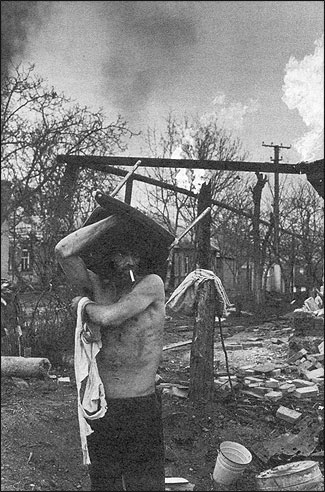
Gas flaring from fractured pipes creates a backdrop for fighters, civilians, stray dogs, cats and deranged homeless victims.
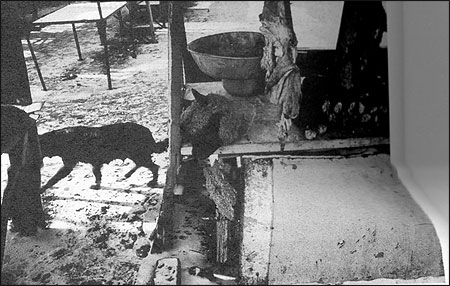
People were afraid to shop at the three main markets in Grozny during a battle in which people were killed daily. Smaller markets away from the main fighting survived, but what few goods remained went unsold for days. Civilians and stray dogs survived together, both hungry because of the fighting.
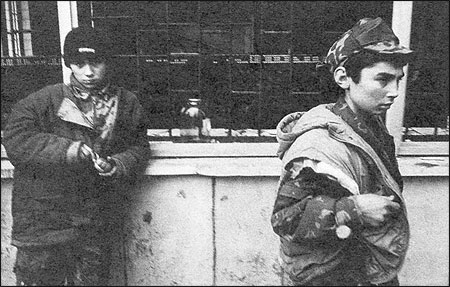
At the 999 bar, in front of a blown-out storefront, young Chechen rebels play with grenades, their toys of war.
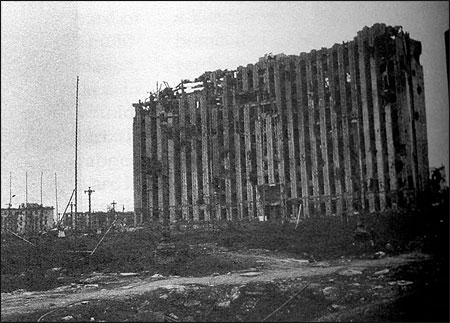
Ruins of the presidential palace in Grozny, Chechnya.
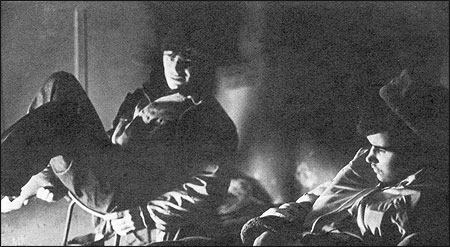
Chechen fighters, waiting for the end of Russian shelling, warm themselves by a fire.

The body of a Russian man killed by mortar fire rots in the streets of Grozny. The bodies of civilians remain on the road because it is too dangerous to move or bury them.
Photos by Stanley Greene/Agence VU.


